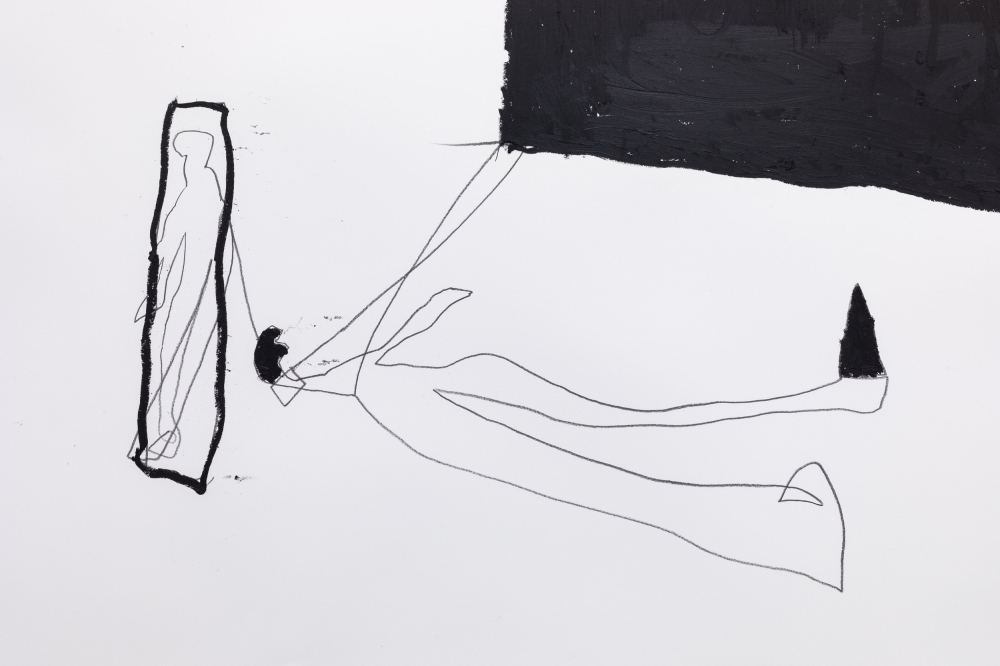Fatima Moallim
“Where the water recedes, crocodiles proliferate”.1
This Somali proverb can be symbolically applied to Fatima Moallim’s work. It has a
special resonance as it comes from her homeland. A place that she has only visited
once. In a figurative sense, the water level in her work is low, one where many crocs
are frolicking. Fears, threats and the existence of an autofictional identity, usually lying
beneath the surface, become visible. This psychological tension is witnessed through
unsettling sounds, that is generated from feelings, memories, dreams, but also from
history and fiction. This sonic impact and force becomes palpable in the form of line
and mark-making.
Her large-format drawings, her preferred medium, act like visual reports from the
inside of a psyche that is strongly affected by sound. The journey from her apartment
to the studio or from the studio to the hospital reveals a broad acoustic spectrum.
From Stockholm to Malmö, New York or Kavala, a peripatetic experience with ever
more intense social expectations imposes itself. The noise of the hectic hustle and
bustle of society, the many (political) forces and directions that seem to emerge on
sidewalks and in traffic are transformed into philosophical and existential questions
before they condense into a visual form and continue to be carried by rhythm, speed
and emotion.
Simone Weil’s thoughts about attention plays a special role in Moallim’s work.
Moallim is self-taught. She does not follow a practice developed at an art academy.
Her practice is oriented towards an attention that leads her to self-forgetfulness
in order to get as close as possible to a subject. “Total attention,” says Weil, “is like
unconsciousness.” It is therefore not surprising that the artist needs a long time for
the motifs to mature in her “inner self,” but the translation onto paper then only takes
a short moment, during which the drawing, receives no further additions. There is a
Zen-like relationship between the long, inner process of maturing a drawing and the
short, focused transfer that many of us lose sight of with our shrinking attention span.
The small oil-stick drawing BESVÄRLIGA LJUD hangs in vicinity to the exhibition’s
entrance. The Swedish title in English translates to something along the lines of
DISTURBING SOUNDS. In this drawing, the perceived noise or chaos overpowers any
recognizable motif. It is a small outcry of powerlessness or perhaps even resignation
to being able to see and understand correlations clearly. However, the work is small in
comparison to the drawings, which are normally up to several meters high and wide. It
seems like a lurking threat of chaos in which a resolution no longer seems possible: a
cacophony of lines.
In MALCOLM’S BROTHER it is ambiguous as to whether it is about a short (invented)
story on one of the travels from A to B, or a reference to the famous Malcolm X. The
drawing, made shortly after her residency at ISCP in New York, shows a large reclining
figure connected by a line to a small standing figure in a box. Could she be referring to
the fact that civil rights activist Malcolm X was assassinated by a ‘brother’ of the Nation
of Islam? Diagonally behind this, in the center of the image, is a black geometric
shape that is not completely filled in, followed by a formation of two rectangles. The
geometric shapes are connected by a line reminiscent of memorials, the one in the
foreground from a frontal perspective, the one in the background from a bird’s eye
view. Places biographically linked to the artist have experienced deep distress: civil
war and terrorization by radical Islamist militias Al-Shabaab in Somalia, religious
violence and intensification of gang warfare and crime in Sweden, and widespread
arming of the population, attacks on the rule of law and racially motivated violence
in the US. The shapes seem like a loose sequence of atrocities and their memorials
in these places, whose continuation is uncertain but not hopeless with the standing
figure in the “present.”
Another historic allusion can be found in the play on words in the title of the drawing
ADAM MADAM. According to the biblical story, Adam is the progenitor of all humans
and Eve, a “madam,” the progenitor mother. The phrase can also be read phonetically
as “mad [I] am” and Adam as “a[h] dam[n]” or extended to the palindrome “Madam
I’m Adam”. In her delight in playing with language and sound, Moallim not only takes
up and perpetuates a gender relationship that has been handed down over thousands
of years. Created during this summer’s Koran burnings in Sweden, the drawing points
to an ideological attempt to conjure an image of polarized worlds.
This new series of seven drawings created for the exhibition evokes the everyday
life of an autofictional multicultural identity and the associated tensions between
cultural mentality, religion, and violence. The noise and sense of social activity are
interrelated with imageries that reflect the psychological well-being of a community.
The works become physical insofar as they examine the noise of everyday life and its
psychosomatic effects on people.
1 Nurrudin Farah uses this proverb in his novel Crossbones, a report on the state of Somalia. The fictional Somali journalist
Malik, who lives in New York City, travels to his homeland to understand and report on the complex state of the civil war-torn
country.
Map
Last Tango
274 Sihlquai
8005 Zürich
Switzerland
Artist(s)
| Details | Name | Portrait |
|---|---|---|
| Fatima Moallim |
Institutions
| Title | Country | City | Details |
|---|---|---|---|
| Last Tango | Switzerland
|
Zürich
|
Switzerland
Zürich
|
